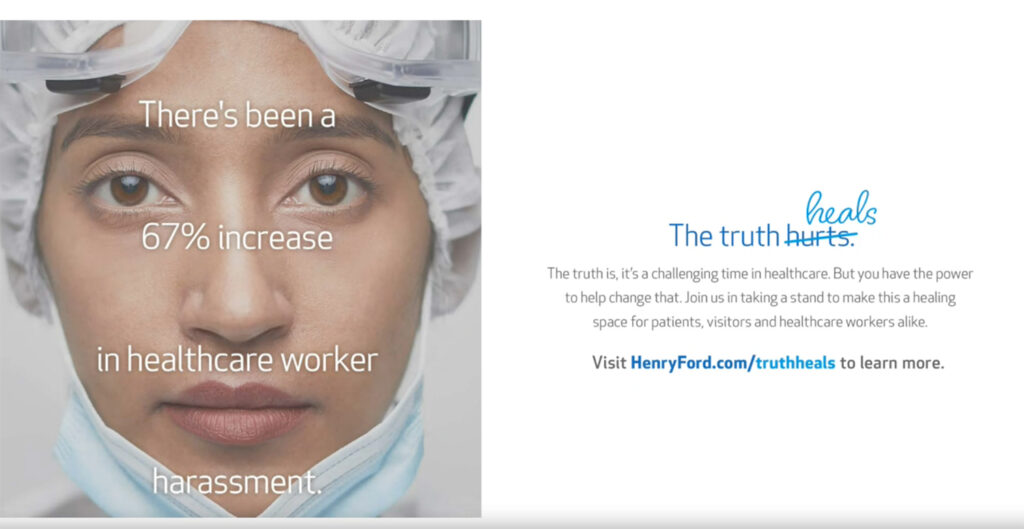Measures to Curb Workforce Violence Ramp Up in Hospitals Across America
U.S. hospitals are seeing a dramatic rise in workplace violence. While some organizations are taking active steps to address the issue — including developing internal and external campaigns — more is needed: Only 43 percent of workers believe their organization’s policies against workplace violence are effective.
// By John Marzano //
 In most hospitals today, electronic medical records and patient portals house patients’ personal health history, enabling convenient access. Now, an unintended consequence is that some patients use this access to bully their providers via threatening email messages. The irony is stunning.
In most hospitals today, electronic medical records and patient portals house patients’ personal health history, enabling convenient access. Now, an unintended consequence is that some patients use this access to bully their providers via threatening email messages. The irony is stunning.

Mark Moore, corporate director of protective and support services at Dayton Children’s Hospital
“The events of the world have created a sense of urgency,” says Mark Moore, a former marine who serves as corporate director of protective and support services at Dayton Children’s Hospital in Ohio. “COVID-19 turned the world on its head, resulting in an increase in incidents of violence brought on primarily by higher levels of patient and family anxiety, staff shortages, and general frustration in people.”
While health care workers are trained to always be ready to comfort after a violent mass casualty event on people in their community, their lives and work environment aren’t always protected in the same way. Even before the pandemic, the U.S. Bureau of Labor Statistics reported that “the health care and social service industries … are five times as likely to suffer a workplace violence injury than workers overall.” (2018).
Here, we look at some of the steps health care organizations, crisis prevention experts, and legislators are taking to combat violence in the workplace, and what your organization can do to protect your greatest asset: your health care workers.
Moore notes that the perceived vulnerability of health care facilities as soft targets — similar to schools — has increased significantly as staff have been injured or killed in shootings in the workplace across the country. “On a single day back in June 2022,” he says, “four staff members were fatally shot in two different adult hospitals — one in Dayton, Ohio, and the other in Tulsa, Oklahoma, where the shooter blamed his surgeon for his back pain.”
The Rise in Workplace Violence in Hospitals is Shocking
Studies show that an alarming 73 percent of all workplace violence occurs in hospitals.
Examples are striking and intensify on a daily basis — patients assaulting physicians and nurses, patients attacking other patients, employees injuring other employees, sometimes armed with weapons, stalking, bullying, racial and ethnic aggressiveness, sexual assaults, deaths resulting from bodily harm, suicides, and surprisingly, even board members cited for disrespect toward employees.
As these occurrences escalate throughout our nation’s hospitals, the impact is felt physically, mentally, and emotionally by health care workers in a place that is supposed to be their personal space of health and safety when caring for patients.
Violence is a growing concern everywhere, yet even the smallest, random act in a health care setting should sound the alarm for immediate action.
Crisis Prevention Institute (CPI) Study Calls for More Employee Training and Support
Workforce violence and other issues were brought to the forefront recently by the Crisis Prevention Institute, a leader in evidence-based de-escalation and crisis prevention training for business and industry. Its survey as part of a Workplace Violence Prevention Training Annual Report for Health Care included more than 3,150 respondents with a median employment tenure of 11 years working in hospitals.

Tony Jace, CEO of the Crisis Prevention Institute
“A national metric on workplace violence doesn’t exist, so we asked the people who understand it best,” says Tony Jace, CEO of the Crisis Prevention Institute, who plans to publish CPI’s report each year. “The rise in work-related violence and mental health concerns over the past five years puts a spotlight on the issue now, and CPI feels a duty to provide a timely mechanism for health care organizations to evaluate their internal education, training programs, and be better prepared to handle these events.”
The CPI annual study grouped data into two categories to summarize respondents’ feelings around the safety of their workplace and their workplace’s preparedness to resolve conflicts.
- The Safe Workplace Index (SWI) defines how safe staff feel, how comfortable they are responding to a crisis, and their belief in the efficacy of their organization’s current policies in reducing violence.
- The Workplace Preparedness Index (WPI) provides an assessment of workplace violence committees, level of staff involvement in violence prevention, and de-escalation training frequency.
The report takes those two main data points and informs individual health care organizations through an overall Workforce Violence Prevention index if they are strong, average, or lagging in the protection of their people.
Notable findings in the study were compelling and indicate that not enough training and preparation against violence is being done to protect health care workers across the U.S.:
- Only a little more than one-third (39 percent) of respondents believe their staff feel comfortable or very comfortable addressing a crisis.
- 40 percent of all respondents believe they are below average as a leading safe workplace; 9 percent believe their workplace is lagging behind.
- Almost one in five respondents believe staff feel very or mostly unsafe (17 percent).
- Less than half — 43 percent — believe their organization’s policies against workplace violence are effective or very effective.
“This is a very big wake-up call to health care leadership and their boards,” says Jace. “The need to provide health care workers with awareness of what can occur, the tools, the training, and the confidence to respond effectively to situations is at a critical point. When organizations enlist that support effectively, our indices show the frequency and severity of violent events can be reduced in half.”
Prioritizing Protection of Health Care Workers
- Worker Safety: Ensuring the safety and well-being of health care workers is paramount. Violence in health care settings poses a significant risk to the physical and psychological safety of staff members.
- Patient Care: Violence against health care workers directly impacts patient care. When staff members are at risk or experience violence, it hinders their ability to provide optimal care to patients.
- Retention and Recruitment: Workplace violence can have a detrimental effect on staff morale and job satisfaction. Health care organizations that prioritize the safety of their employees are more likely to attract and retain skilled health care professionals.
- Reputation and Public Trust: Instances of violence in health care settings can damage an organization’s brand reputation and erode public trust. Patients and their families expect health care institutions to provide a safe environment where they can receive care without fear of violence.
- Cost Reduction: Violence-related incidents can lead to increased costs for health care organizations. These costs can include medical expenses for injured staff members, legal fees, increased insurance premiums, and potential lawsuits.
- Legal and Regulatory Compliance: Health care organizations have a responsibility to comply with legal and regulatory standards related to worker safety. Many jurisdictions have specific requirements in place to protect health care workers from violence. By preparing, organizations mitigate legal and regulatory risks.
Hospitals Respond, Instituting Broader Safety Measures for the Workforce
Hospitals, health networks, and states, through legislation, are quickly adjusting security measures and taking immediate action to shore up protection for their health care workforces. These examples are noteworthy:
- The State of New Jersey has specifically made intentionally threatening health care workers or volunteers while they’re on the job a criminal offense, under a bipartisan law signed by Gov. Phil Murphy. The law, called the “Health Care Heroes Violence Prevention Act” (A-3199), also stiffens penalties for those convicted of assaulting employees.
- In Louisiana, Ochsner Health was able to get legislation passed against health care workplace violence, making it a felony crime.
- The El Camino Healthcare District Board of Directors in California censured a longtime board member following allegations of repeated disrespect toward hospital employees.
- Hospitals and health systems such as Mass General Brigham, Renown Health, Henry Ford Health, and others across the U.S. have developed Zero Tolerance Code of Conduct/Civility programs for patients and visitors to go along with established policies for employee behavior, increased security, and public safety measures.

In a session at HMPS 2023, “From Celebration to Violence,” Ara Telbelian, director of marketing, brand management, and marketing operations at Henry Ford Health, presented a campaign designed to address workplace violence.
- At Indiana University Health, campaign messages are bold and extremely direct, and part of a comprehensive internal/external marketing push to build broad community awareness of the issue.
- Children’s hospitals like Dayton Children’s Hospital, Children’s National in Washington, D.C., and University of Vermont Children’s Hospital are not immune from violence in the workplace. Their safety efforts leverage technology and stealth detection tools to keep weapons from entering the facility; train and educate staff on how to minimize violence when it occurs; and hire public safety officers who blend into the hospital environment.
Are these efforts enough to protect and keep health care workers safe? CPI’s Jace notes that with the heightened anxiety and erosion of trust worldwide, hospitals must take this opportunity to adjust themselves and build back that trust within the workforce through readiness, preparation, and a focus on safety.
“Improvements can be made daily,” he says. “When leadership commits to violence prevention training, they make it easier for health care workers to be better prepared to identify and diffuse potential violence. By helping people bring peaceful resolution to situations that would otherwise turn to conflict, we can help staff, patients, and visitors feel safer.”
“Caregivers are the most valuable resource in any health care setting,” concludes Moore. “Protecting them protects everyone and enables us to fulfill our most basic promise — caring for our patients.”
John Marzano is a highly accomplished, versatile, and strategic marketing and communications professional with 25+ years of experience in multichannel and digital market planning, business partnership development, and communication strategy. Reach him at jam3strategicmarketingandpr.com.

